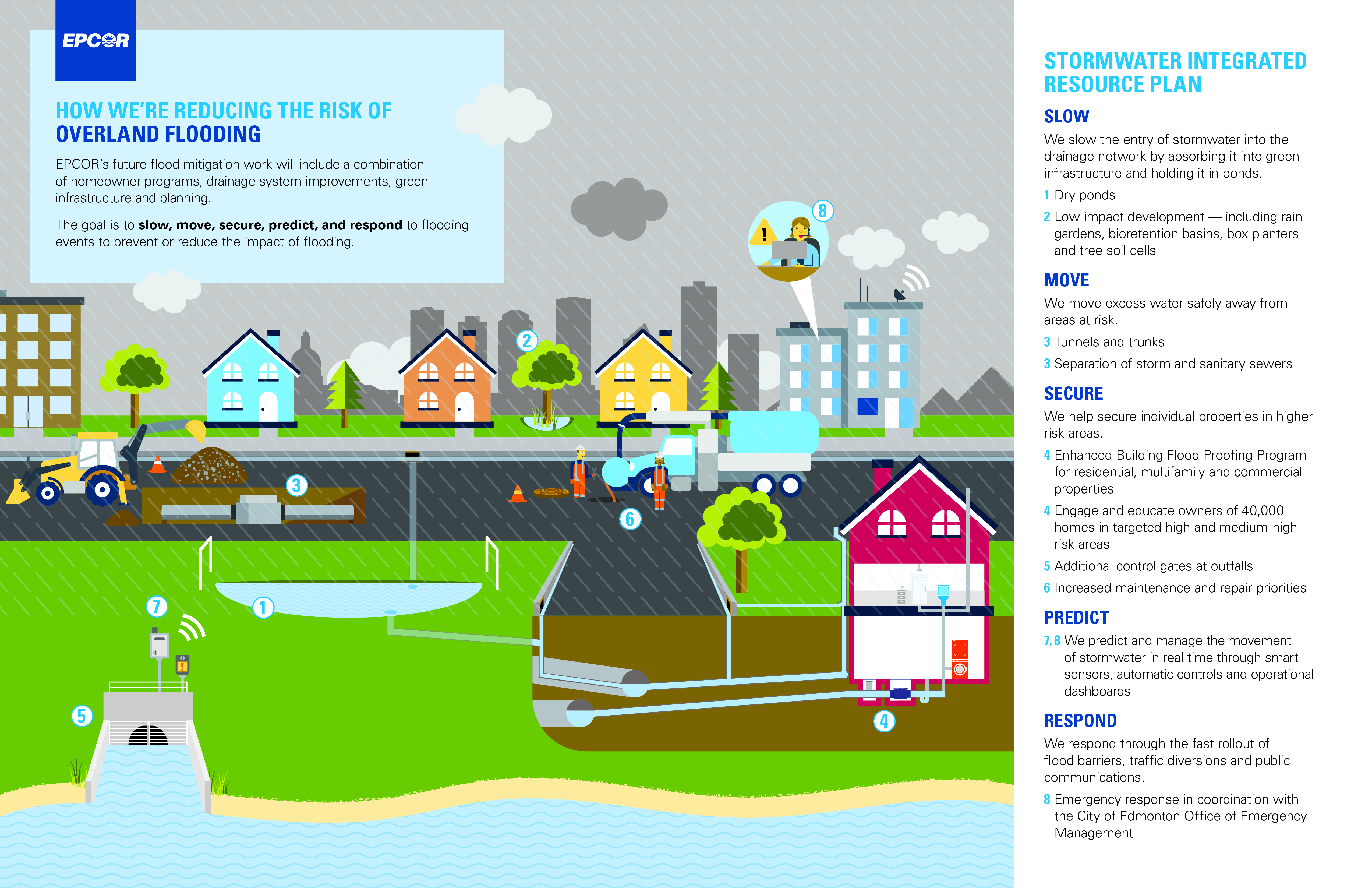Leading an Innovative Multi-Year Flood Protection Plan for Edmonton

When Susan Ancel reflects on the value of her leadership in flood protection planning with EPCOR —Edmonton’s water and wastewater utility provider— she says it’s really about helping people.
That mindset has evolved throughout Ancel’s 30-plus year career in science. It was the opportunity to capitalize on her technical skills and knowledge that led Ancel to pursue her degree in mechanical engineering. But it is the opportunity for collaboration, public engagement and building relationships that drives her work today.
As Director of One Water Planning with EPCOR, Ancel is responsible for overseeing the utility’s Stormwater Integrated Resource Plan (SIRP). The flood protection and mitigation strategy uses innovative techniques to identify areas at risk of flooding throughout the City of Edmonton and provides residents and business owners with essential information to help protect and support their properties.

Although the SIRP strategy is still in its early years — year two of a 20-year rollout — it’s being recognized as a model approach that other municipalities can learn from.
“It’s really an honour for me to get [a Clean50 Award], considering my 30-plus years in this sector and being able to show how my deep knowledge of municipal utility and environmental aspects is able to drive something innovative by taking that One Water lens and being able to share it with others.”
Susan Ancel, 2021
EPCOR’s One Water approach focuses on each element of the water cycle and how collaboration and integration at each phase can provide better support to protect the natural resource and the consumers who depend on it.
“By looking at it through a One Water lens, you’re able to see, for example, shifts in water consumption patterns,” Ancel explains. “This can change the way people are watering their lawns. We can manage the way that runoff comes off that lawn and gets into the stormwater system or goes into the sanitary system and by understanding those interrelations, you can make a more informed design decision.”
The SIRP strategy is a multi-pronged and collaborative approach that invests in five key areas of flood prevention using a comprehensive range of data, including flood risk mapping, historical storm analysis and insurance flood modelling.
By implementing new infrastructure and technology addressing the five central themes – SLOW, MOVE, SECURE, PREDICT, and RESPOND – the goal is to create a more flood-resilient future, protecting the homes, livelihoods and public health of the community.
“The SLOW and the MOVE are really the traditional utilities stuff,” Ancel says. “The MOVE is moving the water through pipes and the SLOW is putting the water in ponds and some of the green infrastructure.”
The SECURE theme centres around ensuring property owners and municipalities have effective floodproofing measures in place to hold additional water volumes back from damaging property. And the PREDICT element revolves around the use of new and innovative technologies to forecast and react to the unique weather events that can cause flooding.
“RESPOND is about effective emergency response and looking at where you are positioned, where you have exercised your plan, if people know where they are going, what type of equipment you are using in that response so that you can effectively deploy,” she adds.
It’s the concept of these five central actions coming together for more robust and innovative flood protection planning that’s garnering praise from industry leaders and sparking other municipalities to take notice. Historically, jurisdictions have based much of their flood preparedness around a mathematical formula that predicts the likelihood of a storm in any one year; the one-in-100-year flood, for example. But the impact of that storm is unique to each municipality and the amount of rainfall that comes with these isolated flood events differs greatly between communities.
By identifying how and where floodwaters can be held back and redirected with new infrastructure and investment throughout each point in a potential flood path, SIRP is intended to protect customers, not just from the peak flow patterns that come with historic flood events, but also from the seasonal impacts of snow and ice melt.
“You’re less focused on the mathematics of how many millimetres of water are falling,” Ancel explains. “Saying you want to protect so that people aren’t experiencing basement flooding puts you in a much different situation than saying I want to manage a one-in-100-year storm. Then you start looking at approaches – I could flood-proof the property or I could move the water to a different location.”
By working closely with partners in the insurance sector, Ancel and her team at EPCOR were able to develop and implement tools to more accurately target and protect neighbourhoods most at risk.
“The data available from the insurance industry is very valuable to understand urban flooding risk,” Ancel says. “In terms of looking at which critical areas should be addressed first, and which homes, schools, health-care facilities and other institutions are at risk from storm events across a spectrum, rather than the single-year design storm model.”
Public engagement was also integral to developing SIRP, as EPCOR surveyed more than 1500 respondents to learn more about what was important to people in developing new flood protection measures and the priorities they placed on how best to direct investments.
Ancel also highlights the free floodproofing home inspections that EPCOR provides as a way to create greater awareness and collaboration with its customers. A property’s flood risk typically comes down to three scenarios – back up through the foundation drain, back up through the sewer system, or poor lot grading. By assessing these three factors, flood prevention advisors offer property owners important information to help target their investments.
“There will be ‘early adopters’ — people spurred to implement new and emerging flood protection measures within their homes and business,” Ancel says. And through targeted outreach to neighbourhood residential organizations, she anticipates interest will continue to grow.
The next phases of SIRP include new investments in green infrastructure and low-impact developments that can be incorporated into urban planning, such as dry ponds, rain gardens and vegetation management.
Through greater collaboration and information sharing between EPCOR and the city of Edmonton, innovative products are also being used to strengthen flood protection when the city replaces ageing infrastructure in residential neighbourhoods.
“Under the sidewalks, we‘re putting tree cells, which are basically a type of green infrastructure,” Ancel explains. “It is a looser soil but still structurally sound enough to hold up the sidewalk and provides more room for the roots to grow and it holds more water during a storm event. It also extends the life of the trees because you have more room for the roots to grow.”

While it’s still early in the implementation of the SIRP, the strategy has opened up cross-sector discussions in the community. Ancel notes that the plan in particular has been integral to shaping the conversation around the value of green infrastructure. For her, that’s a win. She stresses how these innovative design elements are not only beneficial as flood protection measures but they have added benefits in reducing greenhouse gas emissions and improving the overall urban design with more green spaces and trees.
The focus of SIRP over the next decade will be investing in all five themes with a particular focus on the SECURE and RESPOND elements. This phase includes working with home and commercial property owners to secure their properties through new floodproofing measures and responding to areas at the highest risk during flood events with new and innovative reusable flood barriers.
As SIRP continues to be implemented into the 2030s, the PREDICT dimension will prove even more valuable as innovative storm forecasting tools are developed. Ancel stresses this phase is necessary for moving ahead with climate change adaptation as it provides residents and municipalities with additional tools to adapt and react to extreme weather events with the use of tools like sensors, smart roofs and smart rain barrels.
“For me, it is about that partnership in the community. As a utility, it’s not just us selling water and taking away the sewage. We truly have knowledge that we can be a partner in helping a business or a resident be more successful by sharing what we know.”
Susan Ancel, 2021
Leading the development of SIRP has been deeply rewarding for Ancel, as it has provided the opportunity to develop tangible and cost-effective solutions to flood mitigation by building greater relationships between the utility, the municipality, residents and insurance providers.














